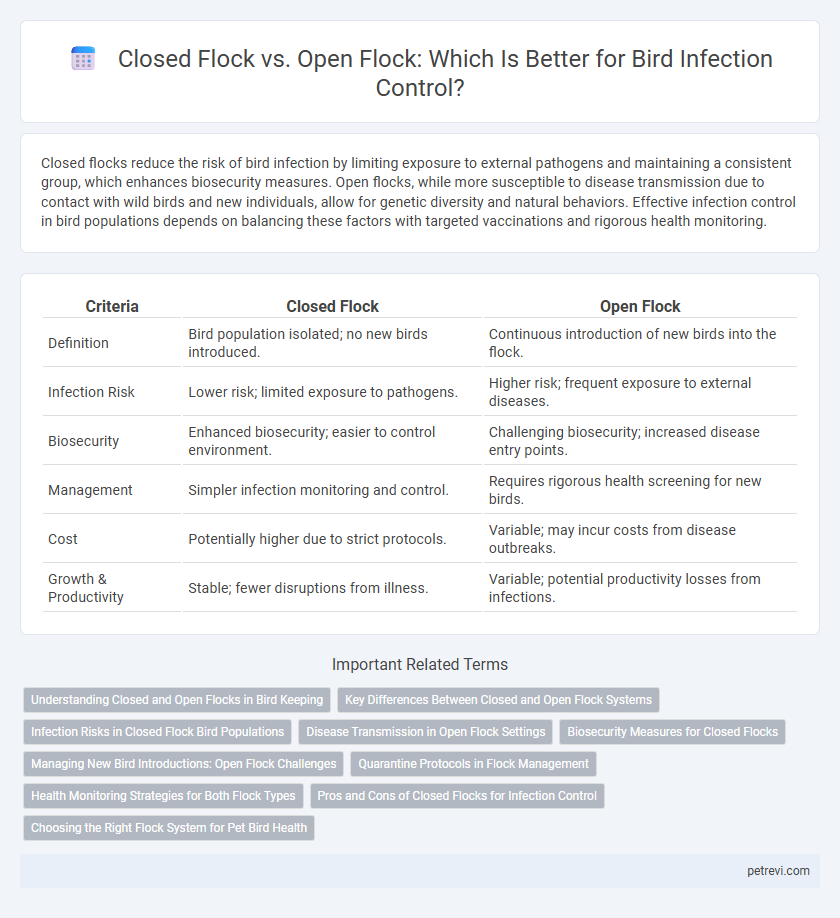Closed flocks reduce the risk of bird infection by limiting exposure to external pathogens and maintaining a consistent group, which enhances biosecurity measures. Open flocks, while more susceptible to disease transmission due to contact with wild birds and new individuals, allow for genetic diversity and natural behaviors. Effective infection control in bird populations depends on balancing these factors with targeted vaccinations and rigorous health monitoring.
Table of Comparison
| Criteria | Closed Flock | Open Flock |
|---|---|---|
| Definition | Bird population isolated; no new birds introduced. | Continuous introduction of new birds into the flock. |
| Infection Risk | Lower risk; limited exposure to pathogens. | Higher risk; frequent exposure to external diseases. |
| Biosecurity | Enhanced biosecurity; easier to control environment. | Challenging biosecurity; increased disease entry points. |
| Management | Simpler infection monitoring and control. | Requires rigorous health screening for new birds. |
| Cost | Potentially higher due to strict protocols. | Variable; may incur costs from disease outbreaks. |
| Growth & Productivity | Stable; fewer disruptions from illness. | Variable; potential productivity losses from infections. |
Understanding Closed and Open Flocks in Bird Keeping
Closed flocks maintain strict biosecurity measures by preventing the introduction of new birds, significantly reducing the risk of disease transmission and infections. Open flocks allow new birds to join, increasing genetic diversity but also heightening vulnerability to pathogens like avian influenza and Newcastle disease. Effective infection control relies on monitoring flock health, quarantine protocols, and minimizing exposure to external sources of infection in both systems.
Key Differences Between Closed and Open Flock Systems
Closed flock systems restrict new bird introductions, minimizing exposure to external pathogens and enhancing biosecurity, which significantly reduces the risk of infectious disease outbreaks. Open flock systems allow the addition of new birds, increasing genetic diversity but exposing the flock to higher infection risks due to potential pathogen entry from external sources. Key differences include biosecurity levels, disease introduction risk, and management complexity, with closed flocks offering tighter infection control compared to the more flexible but riskier open systems.
Infection Risks in Closed Flock Bird Populations
Closed flock bird populations minimize infection risks by restricting external contact and new bird introductions, reducing exposure to pathogens such as avian influenza and Newcastle disease. Strict biosecurity measures in closed flocks help contain infections, preventing outbreaks and limiting disease transmission within the population. In contrast, open flocks face higher infection risks due to frequent interactions with wild birds and new birds, increasing the likelihood of pathogen ingress.
Disease Transmission in Open Flock Settings
Open flock settings significantly increase the risk of disease transmission among birds due to unrestricted movement and interaction with wild populations carrying pathogens. Exposure to contaminated water sources, shared feeding areas, and environmental vectors facilitates the rapid spread of infectious agents like avian influenza and Newcastle disease. Effective biosecurity measures and regular health monitoring are critical to mitigating infection risks in open flock systems.
Biosecurity Measures for Closed Flocks
Closed flock biosecurity measures significantly reduce the risk of infectious disease transmission by restricting bird movement and contact with outside populations. Implementing strict quarantine protocols, controlling visitor access, and maintaining thorough sanitation routines enhance pathogen control within closed flock systems. Continuous health monitoring and vaccination programs further strengthen infection prevention, supporting overall flock health and productivity.
Managing New Bird Introductions: Open Flock Challenges
Managing new bird introductions in open flocks poses significant infection control challenges due to continuous exposure to external pathogens and lack of controlled quarantine measures. Open flocks often experience higher transmission rates of diseases like avian influenza and Newcastle disease, complicating biosecurity efforts. Implementing strict health screening and isolation protocols is crucial to minimize infection risks when integrating new birds into open flock systems.
Quarantine Protocols in Flock Management
Closed flock systems enhance bird infection control by strictly limiting new bird introductions, thereby reducing pathogen exposure and facilitating consistent quarantine protocols. Open flock systems require rigorous quarantine measures for incoming birds to prevent disease transmission, often involving isolation periods ranging from 30 to 45 days with monitoring for clinical signs and diagnostic testing. Effective quarantine protocols in both systems emphasize biosecurity, including dedicated equipment and personnel, to mitigate risks of infection spread within the flock.
Health Monitoring Strategies for Both Flock Types
Closed flocks reduce the risk of infectious disease introduction by limiting contact with outside birds, enabling more controlled health monitoring and biosecurity measures. Open flocks require rigorous health surveillance protocols, including frequent pathogen testing and environmental monitoring, to detect and manage infections early. Implementing tailored vaccination programs and real-time data tracking enhances disease prevention and response in both closed and open flock systems.
Pros and Cons of Closed Flocks for Infection Control
Closed flocks limit the introduction of new birds, reducing the risk of disease transmission by minimizing exposure to external pathogens and enhancing biosecurity measures. However, they may lead to reduced genetic diversity, potentially increasing vulnerability to certain infections and limiting adaptive immunity. Maintaining a strict closed flock system requires rigorous management and heightened monitoring to promptly identify and control emerging infections within the group.
Choosing the Right Flock System for Pet Bird Health
Closed flock systems minimize disease transmission by restricting new bird introductions, creating a stable environment that supports strong immune health in pet birds. Open flocks, while offering greater genetic diversity, pose higher risks for infection due to increased exposure to pathogens from outside sources. Selecting the right flock system involves weighing disease control priorities against the benefits of genetic variation to maintain optimal pet bird health.
Closed flock vs Open flock for Bird infection control Infographic

 petrevi.com
petrevi.com